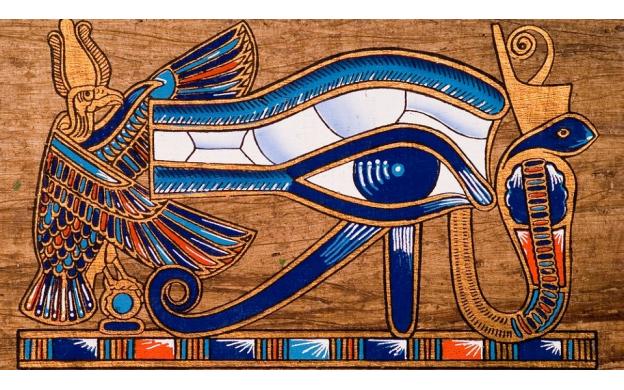Horus, the god of both the daytime sky and of war, is one of the most interesting and confusing of the Egyptian gods. Horus is often depicted as a falcon, or at times as a man with a falcon head–as were many other gods such as Har, Heru, or Hor.1 What is known about him is that he is the son of Osiris and an enemy of Set, the god of the night sky. Horus was, in ancient times, considered to be the perfect god for unifying Upper and Lower Egypt, even before the actual unification took place. This is due to the fact that he was considered the greatest of the gods in both parts of Egypt. The pharaoh was actually considered to be an embodiment of Horus.2
This myth formed the foundations of ancient Egyptian religious faith. This is because when the pharaoh died it was believed that he would become one with Osiris, the father of Horus, ensuring Egyptians eternal life after death. Egyptologist Rosalie David explains, “As the incarnation [flesh-and-blood form] of the god Horus, and the son of Ra and divine heir, only [the pharaoh] could act as mankind’s agent in the presence of the gods. The Egyptians considered the rituals to be effective only if they were enacted by the king to whom the gods had given the rulership. Only he could attend to their needs and execute their orders.”3
Also known as Wadjet, the Eye of Horus is commonly seen as a symbol of protection. The symbol appears in much of the jewelry in the ancient world as it brings about “the safety and health of the bearer and provide wisdom and prosperity.”4 The actual eyes can still be seen today in that they were considered–literally–to be the sun and moon. When Horus was still young, Seth, his uncle and god of the night, tore out his eyes after murdering his father Osiris. This version of the myth is actually quite disturbing as it states that Seth tears out Horus’ left eye, and through an odd set of events loses his man parts! Thoth magically restores the eye after being called upon by Horus’ mother, giving it the name Wadjet, and it is for this reason that the waxing and waning of the moon occurs in cycles and the moon is torn away before its renewal every lunar month.5 On top of that, Thoth resurrected Osiris, granting him eternal life.

In one of the many versions of the myth, the right eye of Horus (representative of the sun) was torn out by Set during battle. Djehuty restored most the eye except for a small piece. This missing part is where the myth of Horus-eye fractions stems from. In this system, parts of the eye were assigned fractional equivalents ranging from 1/2, 1/4, 1/8, 1/16, 1/32, to 1/64.6 When added, these fractions total 63/64, known in mathematical circles as a reciprocal 2n series and a complementary fraction. The Horus-eye of fractions was used for measuring grains and medicines.7
The Wedjat symbol was depicted in a variety of ways in ancient Egypt. Many Egyptians would wear it as an amulet fashioned from gold, silver, granite, hematite, porcelain, or wood.8 It was worn to bring strength, protection, safety, and good health. In a ritualistic sense, the amulet was made as offerings during the summer solstice when the sun was “the most powerful.”9 In fact, the eye still represents a sign that is seen in today’s modern medical vernacular: Rx.10 The Wedjat was printed on papyrus documents containing medical information. The symbol has continued to be used on medical record in Europe, but over time it was replaced by the symbol of Jupiter from Roman mythology, and as even more time passed was changed to the symbol we all know today as Rx.
- Philip’s Encyclopedia, 2007, s.v. “Horus.” ↵
- Philip’s Encyclopedia, 2007, s.v. “Horus.” ↵
- Don Nardo, Egyptian Mythology (Detroit: Lucent Books, 2013), 48. ↵
- Encyclopedia of African Religion, 2009, s.v. “Eye of Horus,” by Denise Martin. ↵
- Encyclopedia of African Religion, 2009, s.v. “Eye of Horus,” by Denise Martin. ↵
- Encyclopedia of African Religion, 2009, s.v. “Eye of Horus,” by Denise Martin. ↵
- Encyclopedia of African Religion, 2009, s.v. “Eye of Horus,” by Denise Martin. ↵
- Encyclopedia of African Religion, 2009, s.v. “Eye of Horus,” by Denise Martin. ↵
- Encyclopedia of African Religion, 2009, s.v. “Eye of Horus,” by Denise Martin. ↵
- Encyclopedia of African Religion, 2009, s.v. “Eye of Horus,” by Denise Martin. ↵



44 comments
Michael Hinojosa
Horus has been and always will be the most confusing Egyptian god to me. From the way he’s depicted in various forms to the fact he’s the god of the daytime and a god of war at the same time. Despite how confusing this god is to me it was interesting to read on the brief backstory of him alongside why his eye is the way that it is! I never knew that it was ripped out and pieced back together.
Antoinette Johnson
The article was intriguing. I am not very versatile on Egyptian Gods, but Horus being a God of unity is always a good thing. Unity brings different people, places, and culture together as one. The Wadjet, the eye of Horus is a symbol of protection that the Egyptians hold dearly to feel safe. This is a good symbol to bring peace and comfort to the Egyptians, so they can be happy and secure.
Annissa Noblejas
The Wadjet became known as a symbol of protection for the Egyptian people. It is the mythical eye of Horus and believed to be responsible for the lunar cycles. The story variation of the eye’s missing piece being responsible for the fraction system is very interesting. (side note: according to Egyptian mythology, it was Osiris who lost his man parts, not Horus)
Valeria Perez
It is interesting to see the way ancient civilizations always have an origin story for everyday events, in this case the moon cycle or day and night. It is also interesting how Horus is both the god of daytime and war. How did that combination come about?
The Egyptians used the symbol of the eye to represent prosperity and now you can see this type of eye jewelry in trendy stores.
Esperanza Rojas
This was really interesting to read about. The greeks have so many symbols in their religion and so many meanings to each of them, especially to know that many come from morbid beginnings. Another thing that caught my attention was that math was used in it, I don’t know exactly how advanced people were in math during this era but it seems to me that in Greek religion, educational subjects are use to support their claim.
Kaitlyn Killebrew
I have seen this symbol when reading about Egyptian mythology but had never known what it was for. To think that its origins were as gruesome as being torn from his head along with his nether regions is gross as well as interesting. It’s strange how they used it a measuring device even though it was no fully complete, 63/64. This article said Horace to be a Pharaoh as well as a good, so he was a living person before he was portrayed as a god?
Honoka Sasahara
It was so interesting to learn about the myth of Egypt and Eye of Horus.
I have never heard about the system of eye or the missing part, so they made me fascinated and want to know that more.
And I learned that ancient Egyptian had thought jewelry or metal such as gold so important, which made it understandable that many ornaments appear in Egyptian history.
Faten Al Shaibi
What an interesting information that the article contain , this the first time I know the meaning of an eye in jewelry,and the story about Horus eye and how he lost it .
Indeed, Egypt’s history is full of events that are difficult to imagine from the past to the present.
I really enjoyed reading this.
Anna Guaderrama
I had never heard about the Eye of Horus or “Wadjet” before so I enjoyed reading this article as I found it very informational. It’s fascinating to read about how this symbol was used as a measuring device for medical purposes. I’ve seen this design before, but I never knew the symbolism it had behind it. I thought this article was so eye opening (not meant to be a pun), it’s crazy to read about how it was used for measuring grains and medicines. It’s even crazier to know that there are different versions and this isn’t the only one.
Alexandra Cantu
I really enjoyed reading this article and how it focused on Horus and his reputation. My favorite part was the mathematical division of the eye of Heron and they’re was a missing piece and it all added up to 63/64. I found that part fascinating! It was very well written article! It was clear and to the point my favorite types of reading.